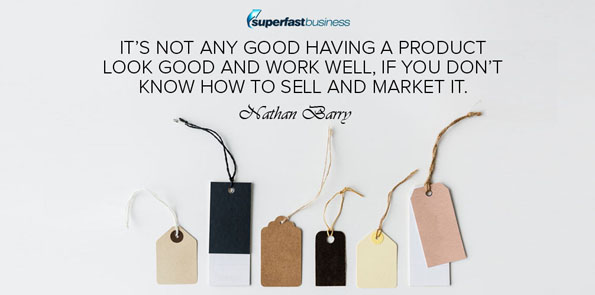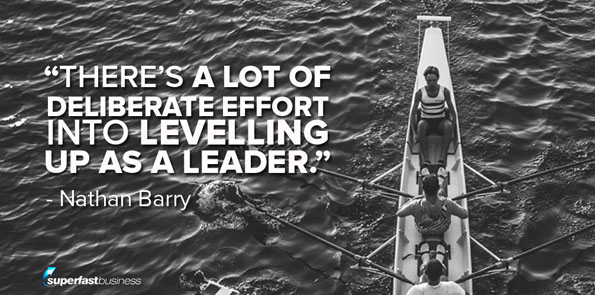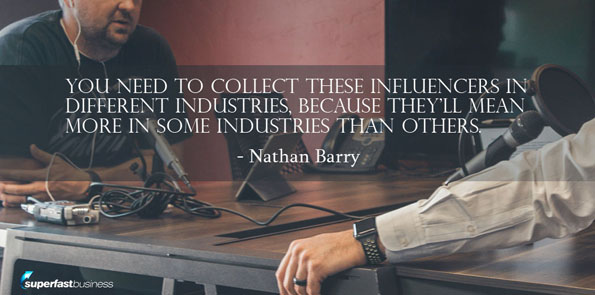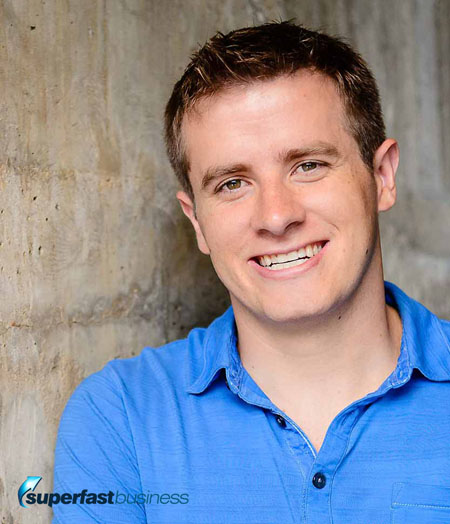Podcast: Download (Duration: 39:02 — 35.9MB)
Get Notified Of Future Episodes Apple Podcasts | Spotify | Amazon Music | Android | Blubrry | Gaana | TuneIn | Deezer | Anghami | RSS | More
In the podcast:
01:01 – A change in branding
04:16 – Nathan’s unique combo
07:40 – The power of good marketing
08:44 – Should you share your numbers?
13:00 – Why Seva doesn’t take funding
16:23 – What must change to reach $100 million?
20:18 – Serving the creative market
23:12 – The leap to “actual famous”
25:54 – A lesson in leadership
30:23 – Team and taxes
32:52 – More influencer marketing?
34:22 – The heartbeat moments
37:51 – More to come
Make significant strides in business growth with James’s personal coaching
Transcription:
James: James Schramko here. Welcome back to SuperFastBusiness.com. This is Episode 595, and we’ll be plotting a journey of growth. And to do that, I thought it would be interesting to bring along a guest who has had significant growth in his time online, going from zero, one can imagine, all the way past the $10 million revenue mark. So there should be some interesting stories in this. I’d like to welcome along Nathan Barry.
Nathan: Hey, thanks for having me on.
A change in branding
James: Now, I could say you were from ConvertKit, but now you’re probably going to tell me that it’s Seva.com. And I think that’s probably a good place to start. Let’s start with where you’re at now, and then we’ll wind back a bit.
Nathan: Yeah, so we just quite recently, July 1st, rebranded from ConvertKit, which I think a lot of people probably listening to this are familiar with, to Seva. And so it’s a big change, but it’s been a long time coming. Let’s have first some quick context – “seva” is a Sanskrit word that means “selfless service”. And so we made the change, really to try to focus on, well, we wanted a better brand name that was less technical.
But really when we think of Seva, we think of the people who are out there really serving their audience, not just maybe trying to make a quick buck on the internet, but they’re the ones who are really trying to deliver value and serve their audience and know that through doing that they’re going to build a great business. So it’s a big change, but it’s been interesting to see everyone respond to it.
“A good brandable short domain name is a winning name.”
James: You know, I see you got some good praise from people who know what the origin means, and depending on which country you’re in, it might be pronounced slightly differently, but I always think a good brandable short domain name is a winning name (says the guy with SuperFastBusiness).
Nathan: Yeah.
James: Somewhat long, but I have had brandables and I think they’re fantastic.
Nathan: Mm-hmm. And we’ve got, I mean Seva is the four-letter domain name. It wasn’t cheap, but you know, I’m excited about that. Like, every time I type in the domain, or like, URL, like “seva.com/brand” to get to our logo assets or something, I’m like, damn, that’s a nice, short URL. So it just makes me happy.
James: A huge portion of the traffic to my website, I think about a third of it, is actually people typing in “superfastbusiness” into Google and then clicking directly on the domain, so that it’s very worthwhile having a brand that people can remember. I was going to ask you if it was hard to get such a short domain and if it was expensive, because I know there are other people out there who have bought single-word domains, that are sort of king in their category, and they’re not cheap. But secondly, I was wondering, what was the origin of ConvertKit? Because I never really understood what that meant.
Nathan: Yeah. So when you’re starting out, like, starting the company, I had a few requirements. One, I wanted to make sure I had a .com, which I don’t know how important that is necessarily for like, the early stage of the company, but ConvertKit really came about because I was using this tool called lean domain search, which, six years later, five and a half years later, is still a great tool on the web. Basically, you give it words, it pairs it automatically with other words, and then gives you the available dot coms back.
And so I had this whole list of words around email and conversions, and subscribing and opt ins, and, you know, whatever else I had, like 30 or 40 of these words that I would plug in there and then see what came back, and “convert” was one of those words. And it happened, you know, in one of the many combinations, it paired it with “kit”. And then I registered that for the… Well, I think I used a GoDaddy coupon code. So I registered that for about $1.99. It was a little cheaper than Seva.
James: Yeah, I ended up getting some domains like James.me and so forth. But I still think .com is a winner, I would tell students. And maybe a possible exception is software, where they seem to be into these ios. I still think having a .com is smart. Because if you don’t own the .com, there’s a pretty good chance you’re going to be sending traffic to the person who does.
Nathan: Right.
James: Which I think one of your competitors has that exact challenge. And I’ve talked about this on the podcast before.
Nathan’s unique combo
You’ve already hinted at some of your values and what drives you. You have an interest in conversions, and from reading the material on your website, it seems that you’ve come from a creative background as a blogger, and you just want to help people who are trying to create stuff to send out their emails and make it easy for them to write the emails and for the emails to get through. But you also have a programming background. It’s actually, I guess it’s kind of rare, where you’ve got geeky technical skills but also the softer, creative, artsy skills. That’s a rare combo.
Nathan: Yeah. I’m kind of obsessed with learning, and I think, early on in my career… So my background is in design. So web design and then into user experience and software design and all that. But I realized something.
This actually is kind of silly where it came from, but at a software company that I worked for, somehow there was this debate over which, if you could only have one skill, which is better – design or development? And the designers were like, oh, design for sure, because, you know, you can make stuff look good, like, look at the program. Without us, what the programmers make would look terrible. And I just remember sitting there thinking, no, development, because without the programmers, this doesn’t even work. Like, we can’t even solve a problem if you don’t have the programmers to actually code it up and make it work. And so it may look terrible without the designer, but at least it functions.
 And so from then on, I was like, Well, I don’t want to be limited in the fact that I can only make something look pretty but I can’t actually make it function. And so then I started getting into programming. And I coded a bunch of my own iPhone apps and a bunch of other stuff, but then I had this thought, well, hold on, it’s not any good having a product, like, look good and work well, if you don’t know how to sell and market it.
And so from then on, I was like, Well, I don’t want to be limited in the fact that I can only make something look pretty but I can’t actually make it function. And so then I started getting into programming. And I coded a bunch of my own iPhone apps and a bunch of other stuff, but then I had this thought, well, hold on, it’s not any good having a product, like, look good and work well, if you don’t know how to sell and market it.
So then I kind of increased the scope of, or like, changed my mindset to this, like, three-legged stool. And it was design, development and marketing. And I just continually looked at, you know, which one of these areas am I the weakest at? And then I would pick a project that would force me to get better, you know, at that one area. And I, I think I’ve always been weakest at development. But that’s kind of been my approach. And that’s how I’ve ended up with the skill set that I have.
James: Yeah, it’s an interesting combo. I think if I had to pick that hierarchy, I would definitely go with marketing first, and then I’d go with design and then lastly, development, because I think that’s probably the order of the relationship between making an income. I’m very fortunate. I came from a sales background and I don’t pretend to be a developer. But luckily, I built a web development business without having the ability to code a line myself. I can make a hyperlink. I should put that out there.
Nathan: That’s right.
James: But I think having that unique insight into development would probably enable you to build a better team, where you’d have a chance of knowing if they’re going to be good or not. And I have read it somewhere else that a good developer you know, could be worth 100 crappy developers. Like, there is such a contrast.
In fact, one of my other students who’s in a very technologically advanced field, they had like a super programmer who was making $100,000 a month because he was just so much better than anyone else they could hire. Like, he was at the absolute top end of his field. So I guess you’d have some ability to detect if someone’s good or not, having an affinity for it, at least.
The power of good marketing
Nathan: Yeah. And at least your, you know, BS indicator of being able to see who’s all talk, like, that certainly helps. The other thing, though, when you combine some basic technical skills with good marketing skills (and by good marketing skills, I really just mean like blogging about building the product that you’re building, like that). This is not rocket science. It’s like, work in public, write blog posts, you know, teach, those kind of things. But then what happens is, you end up getting followed in this.
What happened, in my case, the story of growing ConvertKit, now Seva, was followed by hundreds of developers. And so now when we put out, hey, we’re hiring a senior engineer, then there’s a ton of applicants. And they’re all like, oh, I’ve been following you since I first read about you on Hacker News five years ago. And so you better believe that they’re interested in taking our position over some other random startup, because, like, in that little world, we’re internet-famous, because we combined basic technical ability with decent marketing.
Should you share your numbers?
James: That’s a great way to become an employer of choice, and it’s actually one of the best uses of blogging the journey that I’ve heard, because I will say, I generally advise people against it. I don’t like unnecessary income reporting. I think that’s sort of, and I think you probably did do this, but for the purposes of marketing it kind of lacks a bit of taste. But also, it’s probably unwise at a certain point in your business, it’s unwise to be sharing those numbers, both from a handing your competitors a blueprint right through to, you know, taxation and accounting disclosure. Unless you’re taking funding and you have to publicly report, I generally advise people, steer clear of that. But to attract a crowd of developers, that’s a unique way to use it and a totally valid reason.
Nathan: Right. Obviously, I am on the other side of this, since you can go to Seva.baremetrics.com and see every single number in my business, which I’ve had lots of people tell me, like, don’t do this. Or hey, that was a great idea when you were going up to, you know zero to 100,000 a month, but now that you’re beyond that, like, it’s foolish. And then I’ve had competitors say, hey, by the way, thank you for that. Super appreciate the fact that you publish all of your metrics.
And so if you’re doing it purely as a business, I guess a business move, tactic, something like that, you expect a certain outcome from it. Then you should either not do it, or you should really carefully consider the pros and cons and only do it when it benefits you.
Like for example, MailChimp the last few years has had stories in New York Times written about them that actually include revenue numbers for the first time in a long time. So like, wait, why would they do that? Why would they publicly say, “Hey, we’re at 400 million a year in revenue,” or whatever. And the reason is, because the New York Times is like, “Hey, we’ll run a major story on you if you include some of these details,” right? So they made this tradeoff and said, “We don’t like sharing numbers. But if it means getting this coverage from a paper like New York Times, then it’s worth it.”
But for me, it’s a mission-driven play, where my entire mission is to help creators earn a living. And so I’m going to teach everything that I know on the way to set out these blueprints for someone else to follow in my footsteps. And that means, like, I don’t like when people put out stories and they’re like, “I had a successful product launch,” or, “I’ve built a great business.” And I’m like, what does that mean? I have no idea until you put numbers to it. Because is a successful product launch $10,000? To many people, that’s very successful.
James: Give me a break.
Nathan: You should be very proud of that.
James: Even the $3 million launch, you know, subtract out 30 percent in refunds, and then subtract out the 30 percent in the future payments that are never realized, subtract out 50 percent for affiliates and 10 percent for the copywriter, overwriter and then take out your spike in hosting and in team costs to reselect. The guy’s standing there with a couple of hundred thousand dollars from a $30 million launch, and it is farcical, the launch math that gets bandied around.
Nathan: Right.
James: It’s crazy.
Nathan: But yeah, so in that I want to put out actual numbers that people can track in real time and see so that they can build a better business and see what’s possible. Because I did not, when I was starting ConvertKit, I did not see a clear path to go from, say, $20,000 a month in revenue in a business to $100,000. And I wouldn’t have even dreamed that we’d get to a million a month, because no one had charted that path clearly, or at least in a way that I could relate to. So I’m trying to do that and I know that it costs me business and I know I’ve given my competitors an advantage, but helping these creators and everyone who follows along behind me earn a living is such a key part of my mission that it’s worth the tradeoffs to do it. But if it’s not part of your mission or part of who you are, I wouldn’t do it.
James: Yeah, I think that’s great. I’m glad we had this conversation, because we’re pretty much on the same page, that even you having had great success from it are pointing out some of the reasons why you mightn’t do it. Certainly in my case, I’m happy to be talked about as a seven-figure business, but I’m not revealing my IP outside of my membership program beyond the podcasts that I’m in. Gee, I literally have hundreds and hundreds of podcasts, so I’m definitely doing my bit for the free education by bringing guests like you. You can talk about your numbers.
My trainings that I share every month behind my paywall are as good as you’ll get. Like, I’m releasing fantastic trainings, everything from how to sell your membership on autopilot through to how to build up, make sales from social media marketing, like less than eight minutes a week. Those sort of things are fantastic for paying customers. But that’s my business model. And like you, I’m a private company. I don’t take investment. I will address that right now with you. You’ve stated that you’re never going to take funding. What’s your drive behind that?
Why Seva doesn’t take funding
Nathan: Yeah, so first, I didn’t always feel this strongly. Like, I wasn’t always militant about the funding process. About when we were maybe 100 grand a month in revenue and growing really quickly, I think we were growing 20 to 22 percent month over month, cash was super tight. I was like, Oh, I fully understand why people take investment, because saving up money and then that being counted as profit, having to pay taxes on it, just as you’re like starting a little bit of a nest egg to run the business – it’s such a painful process. And you could just shortcut that by going to an investor and saying, “Hey, would you give me half a million bucks or a million bucks? I’ll stick that in the bank.” You know.
I totally get why people raise funding. For me, I don’t want to sell this company. Like, I want to build it for the next 10, 15 or more years. And so with that, raising funding puts me on this other path, where I do need to get a return for these investors. And so I’ve reached the levels that we’re at now without raising funding, and I really like not having someone saying, “Hey, so when are you going to sell? When are we going to get our exit?” And then also, I like being able to do some of these other things that aren’t just about the bottom line. If we had investors, if they were short-term focused, I think they would think I was completely insane on rebranding. Right? And that’s the thing, that I have a vision for this company and I don’t want any investor or board member having a say of like, ”Hey, you can’t do that.”
James: Don’t you hate that? You know, coming from enterprise companies like Mercedes-Benz and BMW and General Motors and Vodafone, which probably isn’t as well known in the States, but it’s big in the UK…
Nathan: Yeah.
James: I can’t stand bureaucracy and committee decisions. And I’m like, I go wild, my blood boils when people start having a say in it. Even one of my early iterations of my membership was a partnership. And after four years of the balance getting a little more and more lopsided each year, I ended up just liquefying it and like I’m going ownership 100 percent these days. That’s my creative right, the same way that you publish your reports.
It’s my creative right. I think I could make more money, and I can really relate to what you’re saying, you get to that point where you could really do with some extra cash. I haven’t had that in my business because I’m not a software as a service business. I’m not putting these developers on a payroll, and I’m not an ecommerce business. I don’t have a garage full of boxes from China. I’m an information slash education company with a fantastic profit margin. I’m very, very happy about that, and leverage all over the place.
But some of the people I coach, they do go into this state of hyper growth where they’ve found the holy grail, which is an offer that converts – that is the thing that they can offer out to the market that someone will actually give them money for, that works, that they can sell more of, and then they go into hyper growth. They’re hiring… right now, I’ve got three clients hiring four sales people at a time, like Western salespeople in an office, going gangbusters with their offer. And yeah, that cash, I mean it starts to run dry really quickly, even if you have a decent profit margin, because the level just keeps rising. Your new expenses are dramatically increasing as you scale, and your profit can’t quite keep up with it depending on your business model. So I get it.
But good on you for not compromising and for retaining that controlling vote, so to speak. It’s interesting to talk about these choices, because some people at your point, the next natural goal for them is to say, ‘OK, I’ve hit a million a year. I’ve hit 10 million a year. I’m going to make 100 million dollars a year.’
Nathan: Right.
 James: And this is where you have to change the game completely, if you want to do that. I think you have to make some very different business maneuvers than what got you to $10 million a year. Am I right?
James: And this is where you have to change the game completely, if you want to do that. I think you have to make some very different business maneuvers than what got you to $10 million a year. Am I right?
Nathan: Yeah, I think so. And we’re definitely on that path. I’m not ashamed to say at all that the goal very clearly is to grow Seva to $100 million a year.
What must change to reach $100 million?
James: What do you think you’ll have to do differently to get into that zone?
Nathan: Yeah, probably a couple different categories. One, we have to get way better at driving consistent growth. So I’ll name a couple, and then you can dive in on the ones that sound most interesting to you.
So, you know, maybe the smaller-scale promotions or webinars or things like that might not get us to that point, because we just need like a whole other level of consumer who knows about us, right? You have to make the jump to like a Squarespace-level brand or something, or a MailChimp-level brand. That’d be the first one.
 And you need to considerably level up as a leader. Like, the things that you got away with when it was just you and you know, three or four employees or some assistance or something like that, or you can just swap out contractors when they get sick of working with you, because you’re actually totally a pain… I’m certainly not speaking from experience. But yeah, I think there’s a lot of deliberate effort into leveling up as a leader.
And you need to considerably level up as a leader. Like, the things that you got away with when it was just you and you know, three or four employees or some assistance or something like that, or you can just swap out contractors when they get sick of working with you, because you’re actually totally a pain… I’m certainly not speaking from experience. But yeah, I think there’s a lot of deliberate effort into leveling up as a leader.
The name change going from ConvertKit to Seva, is totally around that.
James: Yeah, I was going to say that. That’s mandatory – you can only get so far as ConvertKit.
Nathan: With a name that sounds like a WordPress plugin or a little script that you install.
James: This is such an important point – you have to grow up. You have to grow up to be a $100 million plus enterprise company. you have to be more mature. Like, one of the filters, and I think this is great, you talk about on your marketing material that you’re not trying to trick people with the latest device or technique to make a sale. You like to educate people…
Nathan: Right.
James: …and just create a great product, right? So that’s if I’m reading it right.
Nathan: Yeah, totally.
“Would Apple do that?”
James: And you know, that was one of the filters that I had, is when people are saying “Oh, you should put an exit pop on your page,” or, you should do this or that, and I think, would Apple do that? Is this something that I would expect from Apple or Google or Facebook, or would an enterprise-level company like that say, you know what, that’s lacking in taste and style. We’re not going to have a bold caps headline drive people into an OTO (that’s a one-time offer, in case you’re not sure what that is, listener).
Nathan: I didn’t know what that was.
James: Really?
You know, they say, free this, free this, and you buy it, and then bang! It’s like in your face, this big, like, your last chance, you get like five seconds, they count down – like I just think, would that fly? Now, granted, I still have things like deadline funnels in my marketing. The people get that through a warm path of podcasts and education, and then they get some respectful emails and they’re always invited to opt out and just a gentle process, because I’m looking to preserve that relationship. Even if someone doesn’t buy, I’d like them to still be friends and to stick around.
So it’s really interesting that you’re going to have to find a whole new customer. Maybe those new customers aren’t as interested in income reports or, you know, the blogging crowd that’s like the next stage of enterprise customer. I imagine you’ll have to have things like trade shows and direct enterprise-level sales people and go to lots of board meetings with big companies where you’re planning to do integrations and that sort of stuff. Maybe, you know, print magazines and things.
Serving the creative market
Nathan: Partially. But we’re actually not going to enterprise direction. Like, that is one way to grow the company. And that’s actually probably one of the most effective ways, and we see a lot of software companies continue to go up market. And that’s like a tried and true method. But we actually don’t want to do that. And like our tagline is “email marketing for creators,” and that’s who we want to serve.
Now there’s creators of various audience sizes, but it’s still like a very, you know, I don’t have to put on a suit or show up to a board meeting to sell any of these deals. It’s the kind of people who, you know, they’re a small company. We have creators with massive lists on our platform, ranging from like Tim Ferriss to Gretchen Rubin, to someone like, we have Tim McGraw as a customer.
And people like that, even though they have these big brands and this big reach, they still, you know, it’s still a small team, and they’re creators, and you can reach them directly without having to like change your DNA of who you are, how you sell. And so that’s what we’re going to try to keep, and I think we can do it. And because we don’t have investors, we don’t have anyone telling us that’s cute that you think you’re going to do it that way, but instead you’re going to go up market and here’s your Salesforce integration, now please go close $100,000 a year deals.
James: Right. So what did you mean specifically by a whole new customer, if you’re still with the same type of customer?
Nathan: I think it’s like branching out.
“More of the same good customer.”
James: So, more of the same good customer.
Nathan: More of the same good customer, but like a lot of the circles like, you know, you and I run in, whether it’s our individual communities that we’ve built, or even people like Pat Flynn, like Pat’s a dear friend of mine, and his community and his influence are massive, but in the grand scheme of things, it’s really, really small. Right? If you take half of a step outside of his world, then no one knows who he is. No one knows who I am. No one knows who you are. And so I think we often get in our little bubbles online, and we go through and think that everyone follows the same blogs that we do and everything else. And so what I’m talking about is getting much beyond that.
Like, I’ve had conversations with people who run very successful online businesses, who are in our target market, and they’re like, great, who do you have as customers? And I’ll start listing people off and be like I know Chris Guillebeau, Pat Flynn, Tim Ferriss. And they’ll just like, give me this look that just says, “Cool, I’ll let you know when you say a name that I recognize.” And it just continually shocks me how the little corners of the internet that we run in are so, so small, and we’re just barely scratching the surface of like, even just the creators and bloggers and podcasters that are out there.
The leap to “actual famous”
“Don’t worry about the people who actually know who you are.”
James: Such good points. When people complain that someone’s stolen their product and uploaded it, I’m like, Well, you know, the bigger problem you have is no one actually knows you exist. Don’t worry about the people who actually know who you are. There’s such a huge market. I do think Pat Flynn will become a top tier celebrity over time, because he’s so dedicated to it, and he has natural talent as well. If you combine those two, you get a good combo.
Nathan: Yeah. And anyone who has both, like, sung karaoke with him or competed with him on a basketball court knows about his natural talent. But then yeah, you combine that with just like, relentless execution, and I agree that he’s going to get to that level. I’m actually fascinated. I don’t know if this is the direction that we want to go on this podcast, but I’m fascinated by people who make that leap from maybe, well known in their little circle to internet famous and then to actual famous. So I think of people like Casey Neistat and Ryan Holiday who, I’d still call him internet famous, but then you see stuff that Casey posts and you’re like, oh, you’re actually on the brink between internet famous and actual famous.
James: I think Casey’s actual famous, because I know my non-industry people know who he is, and I think that’s exactly where Pat is at, he’s going to make that jump to actual famous. You know, one of the decisions I made early, and this might be useful for someone who’s not quite at the Nathan Barry stage yet or even where I’m at, it’s I made a conscious decision probably about six or seven years ago, quite some time ago, I actually switched off access to forums and groups that were like internet market-y type demographic. Like, you know, those are the 50-year-old guy in the basement and he’s single and at his mom’s house, like trying to whack up a special offer that he’s going to make a killing over the next few days sort of stuff. Where they go into the fad of the month and start flogging that to all their mates and doing reciprocation mailings and all that, just that awful stuff.
I just left that world and decided to concentrate on a different breed of customer and different forums. So now the people who I’m hanging out with you know, basically a lot of them are making millions of dollars and they have more established, real businesses that actually solve problems for people, that are good for humanity. And I prefer that. And it’s a choice.
“We have to turn off the old to get the new.”
So I think we have to turn off the old to get the new and you’ve just done that. You’ve gone into the cocoon and come out of that as this Seva butterfly to go to the next stage of the journey. I think that’s a smart move. And I can see that trajectory. I mean, to put this in perspective, it was only a little over five years ago you even started this one. Before that, you were tooling around with iOS web apps. Like, you were just sort of mucking around with that. And I think if you go further back from that, you were in politics.
Nathan: Yeah. Well, an intern for the state legislature. Yeah.
James: Has that helped you in running a bigger business, when you’re dealing with team?
Nathan: That’s interesting. So, time with being an intern and working in politics helped me come out of my shell. I was super quiet, shy, and so, you know, having a job like that definitely helped in that way. I don’t know that I took too many other things out of it, but I think the thing that’s actually made the biggest difference in the way I work with a team is something that I’ve been exploring a lot more lately, like particularly the last six or eight months. And that is trying to change my leadership style.
A lesson in leadership
That’s because I went to this event called Reboot, and there they have a website podcast, Reboot.io, speaking of non-.com domain names. But at this event, what they talked so much about is they looked at all these CEOs who were there, like 15 CEOs of really successful companies, and they just said, “Look, you’ve gotten to where you’re at in your career by being a really good problem solver and doing that through pattern matching. So when someone brings you a problem, what you tend to do is listen for the first 30 seconds, pattern-match it to one of the many problems that you’ve solved before, And then when they’re like, ‘What do you think?’ you just say, ‘Here’s the solution. There you go. Done. Next’.”
And then you hear down the road that like, well, first, they say, “Oh, thank you,” and then move on. And then later on, you hear that, like as a leader, your team doesn’t feel like you listened to them, or that they’re really hurting. You’re like, “What? You asked for a solution. I gave you a solution, what more do you want?” And then also, you’re probably pretty frustrated because it’s like, “Why does everyone come to me for everything? Can’t you make your own decisions? Can’t you think for yourself?” I know I definitely felt that.
What the guys at Reboot really encouraged me and the other leaders there to do was to just listen and ask questions and to just not solve other people’s problems. And so it’s hard to do. But I’ve been trying to do that. Or when someone comes to me with a problem, I first actually listen, rather than stopping listening once I come up with my solution, and then just ask questions, usually starting either clarifying questions that dig into the problem, or just, you know, they say like, “That’s the problem. What do you think we should do?” Ask, you know, I’m not sure. What do you think? And almost always, they have a solution. And then the more that you lean into that solution, and you ask questions, refine it, and you see ways where you’re like, Ooh, that’s not my… yes, that’s a solution. That’s not my solution.
But usually, the more you get people to unpack it and think through it, they’ll either refine their solution or they’ll convince you that theirs is better. And I think what’s been magical about doing this is that people tend to feel like you trust them more. They feel like you listened, and then they tend to trust themselves more. I think our team has become a lot more confident and maybe even daring in things they’re willing to try, just because I listened and asked questions. And then the best thing is, there’s all these things that they have the solution for that they don’t bring to me, and I can work on bigger strategic problems rather than being interrupted for some little operations problem.
James: Yeah, exactly right. The real benefit is you don’t have to do the problem solving anymore because you’ve built a team of thinkers.
Nathan: Right. And I think we forget about that, that we are crippling our team continually. Like for anyone who has a team of more than a few people, like every time they’re coming to you with a problem and you’re like, boom, there’s a solution. What more do you need? Like, you just crippled them. You didn’t help them, you crippled them.
“Developing the thinking muscle is so rare.”
James: It’s also very important if you’re a coach, the same thing where I would say that developing the thinking muscle is so rare, you’ve touched on such an important thing. I believe I’ve gotten the most daring Filipinos in the world in my team. They do, they’ll do crazy stuff, risk-free, because we’ve created that environment and they have a process of, I’ve taught them things like 80-20. Like, of the things that we could do, where’s the high impact in this? Let’s focus just on that. And you know, is it a one-way decision, or is it reversible? Because if it’s reversible, there’s not that much risk to try it anyway.
And we can give coaching students a framework that they can use before they come to you, like they can just sit down for a second and think about what happened as a result of that, what did you try or do next, what do you think the next solutions are, what are your options? And they’ll bring that to me to talk about and then we do it. And you’re right, it’s so hard not to jump in with the answer.
But usually on my calls, I always do a diagnostic, right? I leave no assumptions. Full diagnostic. And I know the answer before we start the call, with a high degree of certainty, but I have to go through the call and let the customer arrive at the decision by joining all the dots and feeling ownership of that choice. And usually it will align with where we’re at. And sometimes we’ll discover subtle things that only they know, because of their unique position in the market or their customer knowledge, their expertise.
Like for example, if I was coaching you, you know a lot more about your customers than I do, because you’ve been in the trenches for years. And then there’s a whole bunch of stuff that you probably don’t know yet that I might have seen with a bunch of other customers who have been through the same journey. So if you combine that and everyone’s being respectful and listening and feeling involved, then that’s a magical thing.
Team and taxes
How big is your team?
Nathan: We’re at 37 people now.
James: What a great size. It’s a good size, isn’t it?
Nathan: Yeah, it is. I’m having a lot of fun.
James: Is running a software business very expensive in terms of, you’ve talked about your revenue numbers, but do you have to spend a lot of that back on wages and other costs?
Nathan: Yeah, we spent quite a bit of it. Just for some context, I was going to pull this up because I just sent it to some attorneys for various numbers. But last year, we did 9.4 million in revenue, and then 2.5 million in profit. So it gives you an idea of how it plays out.
James: Twenty-five percent profit margin give or take.
Nathan: Yeah, just shy of that.
James: Maybe a little on top.
Well, congratulations, by the way. I’m sure a lot of people listening to this are thinking, I could be happy with 2.5. I’ve reached a million dollars profit before, and I remember feeling a deep sense of satisfaction, which is, just for perspective, that’s off like, 2.7 in revenues. It’s a high profit margin, and my biggest cost was team. At that time, we had 65 people, but they were thankfully in a lower-priced country.
Nathan: Cost of living.
James: Yeah.
Nathan: Yeah, we pay US salaries. The majority of our team is in the US, and so we pay US salaries there. But what’s interesting is last year was mostly about building up our bank balances. And so out of that 2.5 million, the majority just went in the bank to support the run rate, like to extend the number of days’ worth of cash in the bank that we had.
James: Self-funded line of credit.
Nathan: Yeah, exactly. And then, you know, 1.1 million of that went to taxes. And so it’s like there’s not actually that much money left over, which is the joy of business.
James: The whole tax thing kind of sucks. But then, you know, if you end up in a hospital or, you know, you need a policeman or something, at least you got nice roads. And having, I’m sure you’ve traveled a fair bit, visiting developing nations, and you realize what’s missing, and it does make a big difference in the quality of life.
Nathan: Oh, sure. Yeah, and just your ability to start a business and everything else.
James: You said, you know your best customers, like, that’s one of your mantras. And like, I like this concept of quick wins. When I’m helping someone, I sort of have a look at, OK, what’s your number one lead source? And what’s your number one conversion device? And what’s your number one product and which is your most scalable product? Who’s the number one person in your team? What’s your number one retention or churn-lowering device? These sort of things, like doubling down on the winners, I guess you’d call this strategy.
More influencer marketing?
It seems like influencer marketing has helped you to some extent. Is that something you could see yourself doing more of?
 Nathan: Yeah. I mean, it has in a huge way. And I guess, from two perspectives. One, everyone always, especially as your untried product, everyone wants to know, “Yeah, well who uses you?” You know, we had this back in the early days of when we had like a hundred customers and just getting a customer that they’ve heard of is going to make all the difference. And so that’s a form of influencer marketing, I think, where like, we’re going to make this whole push into the music space, and so being able to point to someone, you know, like, if I go into country music, if someone’s like, “Yeah, well, who uses you?” Now, I can point to oh, well, Tim McGraw. Right? He’s not out there promoting us, but he’s given us a testimonial. He’s given us the ability to use his name. And so then then they’re like, Oh. Well, as a musician, you know, Tim McGraw has a few, a million fans more than I do. And so then that’s a form of influencer marketing that gets past that. And so you just have to know that you need to collect these influencers in different industries, because they’ll mean more in some industries than others.
Nathan: Yeah. I mean, it has in a huge way. And I guess, from two perspectives. One, everyone always, especially as your untried product, everyone wants to know, “Yeah, well who uses you?” You know, we had this back in the early days of when we had like a hundred customers and just getting a customer that they’ve heard of is going to make all the difference. And so that’s a form of influencer marketing, I think, where like, we’re going to make this whole push into the music space, and so being able to point to someone, you know, like, if I go into country music, if someone’s like, “Yeah, well, who uses you?” Now, I can point to oh, well, Tim McGraw. Right? He’s not out there promoting us, but he’s given us a testimonial. He’s given us the ability to use his name. And so then then they’re like, Oh. Well, as a musician, you know, Tim McGraw has a few, a million fans more than I do. And so then that’s a form of influencer marketing that gets past that. And so you just have to know that you need to collect these influencers in different industries, because they’ll mean more in some industries than others.
And then there’s the other side of it, of all the amazing people. The, you know, Pat Flynns and Chris Guillebeaus and so many other people in the world who have done all these webinars and actually directly promoted our product. And that’s been absolutely key. Seva as a company would not be there without like all the promotional work that they’ve put into it.
James: Yeah, well, I imagine that Google Alerts are going berserk right now on off our transcript.
Nathan: That’s right.
James: There’s so much I want to ask you. Like, have you had any catastrophic momentum stoppers? Like just like heartbeat moments or loss of confidence where you nearly threw in the towel? I know it’s too much of a stereotypical question, but I have to ask. It wouldn’t be much of a narrative without the imperative danger zone, you know, the recovery, etc. Was there anything like that? Or has it been smooth sailing?
The heartbeat moments
Nathan: Well, it’s been a lot of work. We’ve run out of cash entirely twice. And then it’s magically worked out of like, we ran out of cash completely, but not more than completely, you know. Like the timing works out down to a month or two where it’s all fine. Side note, if you’re an entrepreneur out there who is thinking you’ll never run out of cash and you have access to a line of credit, just know that it’s easy to get one now, very, very hard to get one when you actually need it. At least for me, from my experience.
I’ll share one that’s recent, that we’re kind of in the middle of right now. It’s not like a show stopping thing, but it’s definitely a Oh, did we just screw something up? Like, how much revenue did we just cost ourselves? Because I think everyone talks about, like, Oh, I’m data-driven. I love experiments. I’m always testing things, I’m always learning. And then the examples that they share from that are always like, yeah, and of course, it went well for me.
But one that we’re in the middle of right now is we changed our entire signup flow, where it used to be that you would put in a credit card or you sign up for a trial, and as part of that, you needed to put in a credit card that we wouldn’t charge for 14 days or 30 days, if you’re on a special promotion. But the default from signing up for that trial was that you would end up becoming a customer. And we changed that recently where we pushed it off so that you could sign up for a trial without a credit card. And then after 14 days from the trial was up, you needed to add a credit card and sign up there.
And, you know, the theory is that ultimately by getting more people into the product, you would end up with a higher conversion rate this way and then a lower churn rate, because only people who are seriously deliberately signing up at the end of the trial would end up as customers.
So we rolled this out in late April, it’s mid-July right now. And it just absolutely hammered our growth. Like, we forecasted that in June we’d grow by 25,000 for the month, and grow our monthly recurring revenue by 25,000. And we actually ended up slightly negative for the month for the first time ever. And so that’s one that we’re in the middle of, you know, it’s highlighted a lot of problems that we’re trying to solve and fix each one and get our onboarding flow figured out and all this other stuff. But then at the same time, it’s like, oh, man, this is clearly performing worse, I think, but some of the data takes a long time to find because you have to wait to find out churn rate.
And so that’s one of those things where you run this math forward over a couple of months. So far, it appears like I’m down maybe 50,000 in monthly recurring revenue. I play that for a year. That’s a lot of money. That’s $600,000 in total revenue. And so this quest for experimenting and trying new things and pushing your own limits, sometimes, is very, very expensive.
And so we’ve had to level up a lot in the process to try to learn. Okay, is our data accurate? Are we asking the right questions, and are we really learning from this?
James: Yeah, it’s a really good point. We can have our great theory and then it does take a while for a cohort to work its way through the python, doesn’t it?
Nathan: Yes, it does.
James: Ideally, it’s good to test small and roll out big, but sometimes that’s not practical. And there’s even consumer law challenges sometimes with testing. It can be awkward, offering one thing to someone and not someone else. So it’s always all these beautiful little side alleys you can get taken down.
More to come
I feel like I could talk to you for hours. And I am respectful of your time. So I’m going to invite you to come back and share some more in another edition, if you would be up to it, Nathan.
Nathan: Yeah, that would be fun.
James: That’d be great, because I still think you’re going to be interesting to track with what happens. Maybe we can follow up with where you, you know, did it cost you 600? Or did it come good, the cliffhanger so to speak.
Nathan: Yeah.
James: You know, see if you’re still happy with your brand name and if it made any other changes.
Nathan: Right.
James: Also, it’s just been joyful chatting with you. It’s very interesting where you’re at. Huge congratulations. And you have taken a different path than many others and you’re getting different results too. So it’s such a great case study of a software as a service success story. And I’ll put a link of course. I’m sure by now, everyone knows you’re at Seva.com. And I’ve been speaking with Nathan Barry. Thanks so much for sharing.
Nathan: Yeah, thanks for having me on.
Update July 30, 2018: Convertkit decided to stay as Convertkit.
Get the resources you need to hit your business goals inside JamesSchramko membership
Likes this episode? Leave us a review on iTunes










Really interesting to hear about Nathan’s point of view. I do agree, in a sense, that it all boils down to good marketing, but the other two are still crucial to a great product.
Really interesting to hear about Nathan’s point of view. I do agree, in a sense, that it all boils down to good marketing, but the other two are still crucial to a great product.
Really interesting to hear about Nathan’s point of view. I do agree, in a sense, that it all boils down to good marketing, but the other two are still crucial to a great product.
So much to get right!! Always a challenge as we saw after this podcast where the name Seva.com became unusable causing a big shift back to ConvertKit.com.